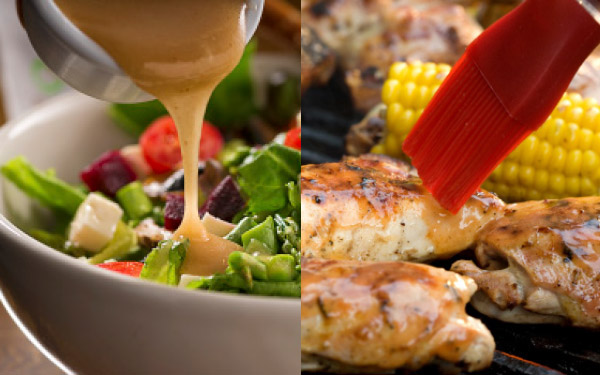
Cooking Class: DIY Vinaigrettes & Marinades
Vinaigrettes & Marinades:
What’s the Difference?
A vinaigrette can be a marinade, but every marinade is not necessarily a vinaigrette. Coating raw foods in marinades for a period of time before cooking can enhance flavor and texture. Vinaigrettes contain a mixture of oil and acid that can function as a dressing or marinade.
Vinaigrettes:
While the order of ingredients matters when prepping vinaigrettes, there’s plenty of leeway to the formula. Use these tips to create delicious DIY vinaigrettes for salads, meats, fruits, sandwiches and more!
• The acid-to-oil ratio plays a vital role in creating a well-balanced vinaigrette. The general rule of thumb is roughly one part acid to three parts oil, but this isn’t set in stone. Adjust to your taste!
• Choose high-quality oils and experiment with varieties like extra virgin olive oil, canola oil and sesame oil.
• Vinegars range in acidity levels; a higher level of acid means a more pungent vinegar. Try red or white wine, apple cider or rice vinegar, or experiment with citrus fruits like lemons, limes, grapefruits and oranges for a bright sweetness. If your vinaigrette is overly acidic, balance it out with salt and sweeteners like honey.
• Boost the flavor of vinaigrettes with fresh herbs and spices like basil, parsley or oregano, plus cumin or crushed red pepper flakes. Crumbled cheeses, garlic, capers and olives add a salty, savory dimension.
• Since oil and vinegar don’t combine on their own, you’ll need an emulsifier, or an ingredient that bonds the oil and vinegar together. Dijon mustard, tomato paste and tahini are great options. Combine vinegar, spices and seasonings, and the emulsifier. Then slowly drizzle in the oil in a steady stream while constantly whisking to emulsify. Whisk until the vinaigrette thickens to your desired consistency.
Marinades:
Unlike vinaigrettes, marinades don’t require any order of mixing. Simply combine the mixture, pour over your ingredients and let the marinade work its magic!
Making memorable marinades that tenderize and add flavor means finding new combinations of acidic liquids, oils, plus herbs and spices. For beef and pork, plan on 1/4 cup of marinade per pound and a bit less for poultry, fish and vegetables.
Oils & Fats: Oils help seal flavors into foods while keeping them moist. When selecting an oil, consider how strong of a flavor you want. To avoid overpowering the seasonings, choose neutral-flavored oils like olive or canola. Use peanut oil, sesame oil or avocado oil for more pronounced flavors.
Acids: Choose vinegar, fruit juice, wine or a combination to help tenderize proteins and vegetables.
Herbs & Spices: From dried basil and citrus peel to paprika and grated ginger, there are so many ways to spice up your marinades. Experiment with different varieties to make your final product look and taste unique.
Honey: Adding honey preserves the shelf life of marinades, enhances caramelization, helps mellow acids and adds the perfect amount of sweetness. Just remember, a few tablespoons will go a long way.
